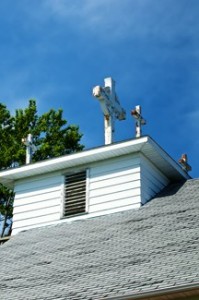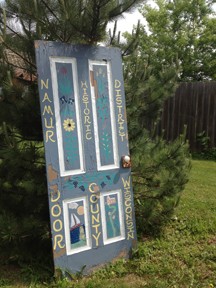Celebrating Belgian Heritage in Southern Door County
- Share
- Tweet
- Pin
- Share
You might not expect visiting Southern Door County to be much like taking a European vacation. But if you get off of the big highway between Green Bay and Sturgeon Bay, you’ll pass Brussels, Namur and Luxemburg, businesses selling Belgian breakfasts, chocolate and beer and a countryside dotted with brick, Belgian-style homes.

The former St. Mary of the Snows church in Namur has been converted to the Belgian Heritage Center, a place to learn about and celebrate the strong Belgian-American heritage in Southern Door County. Photo by Len Villano.
That’s because the Brussels area of Door County is the largest Belgian-American settlement in the country, even 150 years after the first Belgian settlers set foot on the land. While most ethnic settlements have diversified, the Belgian heritage in Southern Door County remains strong.
“It’s pretty homogenous,” Bill Chaudoir said. “If you survey the residents of the area, like 80 percent of them have a strong Walloon Belgian heritage, which is pretty unusual. Usually after 150 years the population is pretty diluted.”
The local Belgian-Americans don’t just celebrate their heritage in Wisconsin. Many participate in cultural exchanges with heritage clubs in Belgium, and travel back and forth to visit distant relatives and learn more about their ancestry.
“If we go to a cemetery around here it’s almost like going to a cemetery in Belgium. Most of the names are the same,” Hillard De Keyser said after eating a Belgian breakfast of eggs, potato salad and trippe, a sausage made with cabbage.
De Keyser is president of the Peninsula Belgian American Club, one of the local clubs dedicated to promoting the history of the area’s Belgian settlers. He grew up in Southern Door County and was baptized, confirmed and married in St. Mary of the Snows Catholic Church in Namur. His wife Donna was born in a room behind the bar next to the church.
St. Mary of the Snows has become the hub of Belgian-American culture. In 2010 it became the Belgian Heritage Center, after the Green Bay diocese moved all its services to the Brussels church.
“If they didn’t find a reasonable use for it, it was probably going to be demolished,” Chaudoir said. “A bunch of us stepped up and decided we should save the building. It’s in pretty good shape and would be a good home to tell the Belgian heritage story in Northeast Wisconsin.”
Chaudoir and others interested in their ancestry started the Namur Belgian Heritage Foundation and dedicated the group to saving St. Mary of the Snows and turning it into a Belgian heritage center.

Chaudoir is 100 percent Belgian stock. He grew up in the Namur area, went to catechism in the schoolhouse next to St. Mary of the Snows and wants to promote the culture.
“It’s kind of a unique story,” he said. “We think it’s a story that’s worth telling and that’s what we hope to do in the Belgian Heritage Center – have exhibits that tell the story of the settlement and what’s unique about it.”
Besides being the largest Belgian-American settlement in the country, Southern Door County may be one of the only places Walloon, a language spoken in parts of Belgium, is spoken casually. Most people of Belgian heritage in Southern Door trace their ancestors to the Walloon area of Belgium, not the Flemish, and some still speak the language.
Lynda Baudhuin, whose husband spoke only Walloon until he was in seventh grade, said few, if any, young people speak the language.
“There was a time some people were trying to teach it to the young people, but they didn’t seem to have the interest, which is sad because it’s a dying language,” Baudhuin said.
Trying to get local kids interested in Belgian-American heritage is tough. While some young families and children attend clubs’ fundraisers and events, De Keyser said the Peninsula Belgian American Club is getting older, and reaching out to the younger generation takes a lot of work.
“Our goal is to keep it moving and keep it going so it doesn’t die,” De Keyser said. “Once the older generation’s gone it will be deleted, and we can’t let that happen because there’s so much history here.”
But that’s one thing the Namur Belgian Heritage Foundation is out to do – jumpstart the understanding, celebration and pride in Southern Door County’s Belgian heritage.
The foundation plans to continue restoring the center to make it both historically accurate and handicap accessible, and host cultural celebrations, private events and historical exhibits. The foundation is continuing to fundraise, and will kick off a new fundraising effort this fall.
“I think most people recognize it’s kind of unique to have the concentration of unique buildings and having the cultural events and the foods carried on all these years,” Chaudoir said. “It’s kind of a neat thing and would be a shame to see it end. Our heritage center is going to be a stimulus to celebrate the fact that it is unique and it’s worth saving these things and celebrating them and carrying them on to future generations.”
